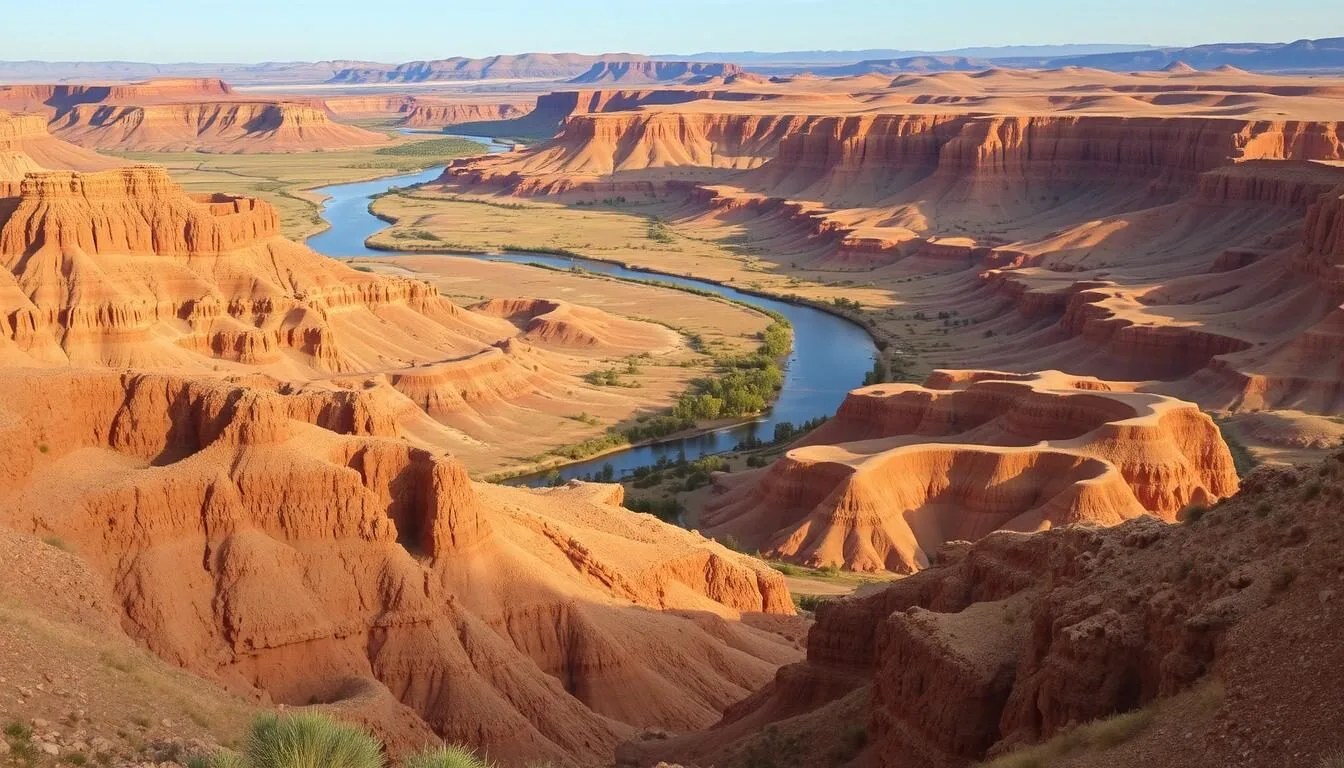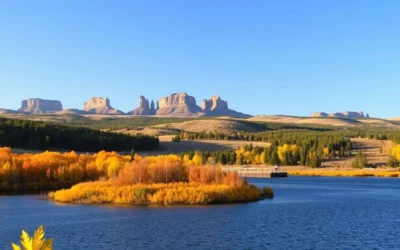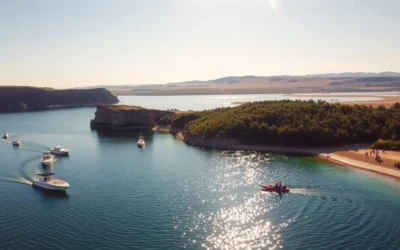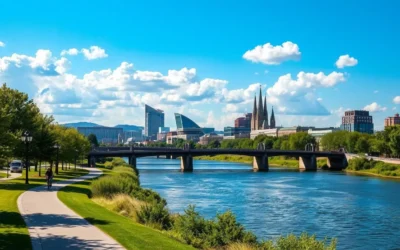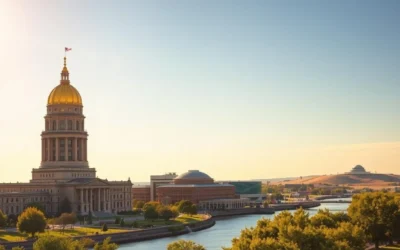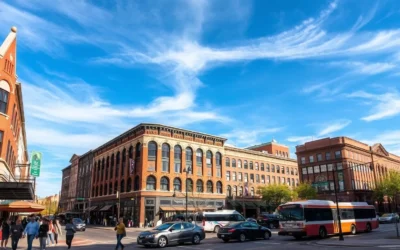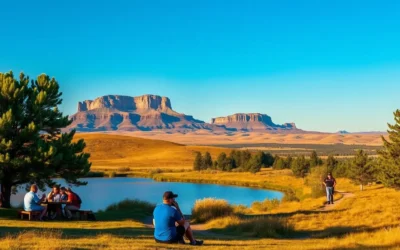Imagine a place where bison, feral horses, and elk roam free across a vast expanse of badlands and grasslands. Spanning over 70,000 acres, Theodore Roosevelt National Park is a treasure trove of natural wonders, rich in history and wildlife.
This stunning park is divided into three units, each offering a unique experience. You can explore the colorful bentonite hills, hike through scenic trails, or take a leisurely drive along the winding roads that crisscross the park.
As you visit this national park, you’ll discover a diverse array of wildlife, including prairie dogs and numerous bird species, making it a paradise for nature lovers and photographers alike.
Discovering the Rugged Beauty of Theodore Roosevelt National Park
As you step into Theodore Roosevelt National Park, you’ll be greeted by the dramatic landscapes of North Dakota’s badlands. This national park is a testament to the natural beauty that has been shaped by millions of years of erosion, creating a unique landscape of colorful buttes, canyons, and plateaus.
![]()
Park Overview and Geography
Theodore Roosevelt National Park is divided into three distinct units: the South Unit, the North Unit, and the Elkhorn Ranch Unit. The South Unit, located near Medora just off Interstate 94, is the most accessible and visited area. It is further divided into three regions: Painted Canyon in the east, Scenic Loop Drive in the central area, and Petrified Forest in the west. The North Unit, about an hour’s drive north, offers a more remote experience with deeper canyons and more dramatic landscapes.
The park’s geography is a mix of prairie grasslands, rugged badlands formations, and riparian areas along the Little Missouri River. This diverse landscape supports a wide range of wildlife and offers visitors a variety of experiences, from hiking and wildlife viewing to exploring the park’s scenic drives.
Best Times to Visit
The best times to visit Theodore Roosevelt National Park are during the spring (April-June) and fall (September-October). These seasons offer moderate temperatures and fewer crowds, making them ideal for hiking and exploring the park. Spring brings wildflower blooms, while fall is known for its vibrant foliage colors. Summer is warm and ideal for water activities, but it also attracts larger crowds. Winter transforms the park into a serene landscape, perfect for cross-country skiing and snowshoeing, though services are limited during this season.
Exploring the South Unit’s Highlights
The South Unit is the heart of Theodore Roosevelt National Park, offering a diverse range of experiences for visitors. As the primary gateway to the park, it provides the most developed facilities and a wide range of attractions accessible via the 36-mile Scenic Loop Drive.
Maltese Cross Cabin
The Maltese Cross Cabin, constructed in the late 1800s, was Theodore Roosevelt’s first home in the Dakota Territory. This historic cabin has been preserved and relocated behind the South Unit Visitor Center for easy exploration, offering a glimpse into Roosevelt’s life and the region’s history.
Painted Canyon Visitor Center and Overlook
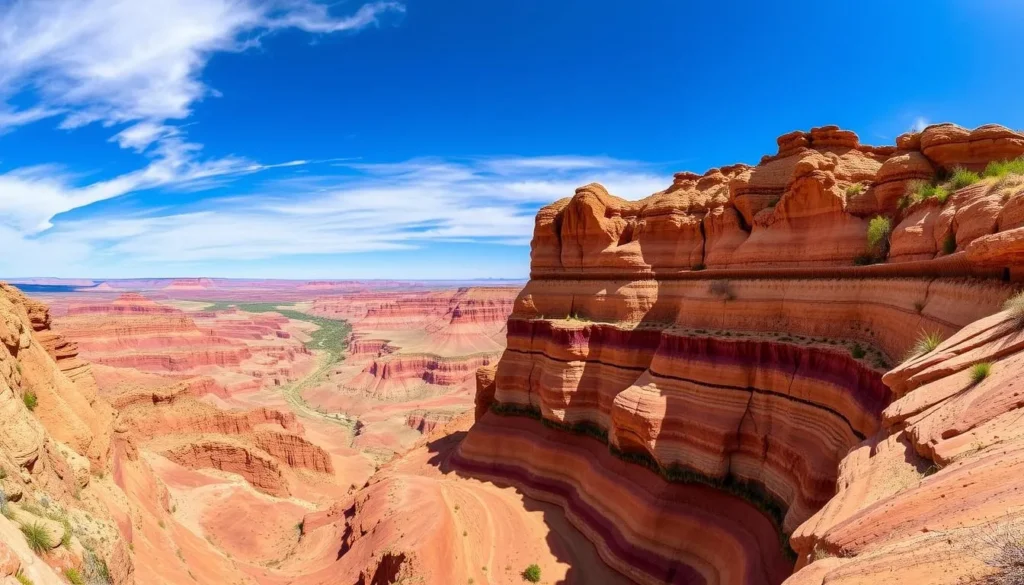
The Painted Canyon Visitor Center and Overlook provides a dramatic introduction to the badlands landscape, with stunning views of the canyon’s vibrant colors and geological formations. Located right off Interstate 94, it’s a convenient stop for visitors to learn about the park’s geology and history through informative exhibits.
South Unit Visitor Center
At the South Unit Visitor Center in Medora, you’ll find helpful rangers, educational displays, a park film, and the opportunity to join ranger-led programs during the summer season. This center is a valuable resource for planning your visit and gaining insights into the park’s natural and cultural resources.
The South Unit offers the greatest concentration of wildlife viewing opportunities, particularly for bison herds and prairie dog towns that dot the landscape. With its proximity to the charming western town of Medora, you can easily combine your park visit with dining, shopping, and cultural experiences nearby.
Driving the Scenic Loop Drive in the South Unit
Embark on a journey through the rugged beauty of the South Unit with the 36-mile Scenic Loop Drive. Although currently, part of the road is closed between miles 24 to 28, requiring an out-and-back approach, the drive remains an unforgettable experience.
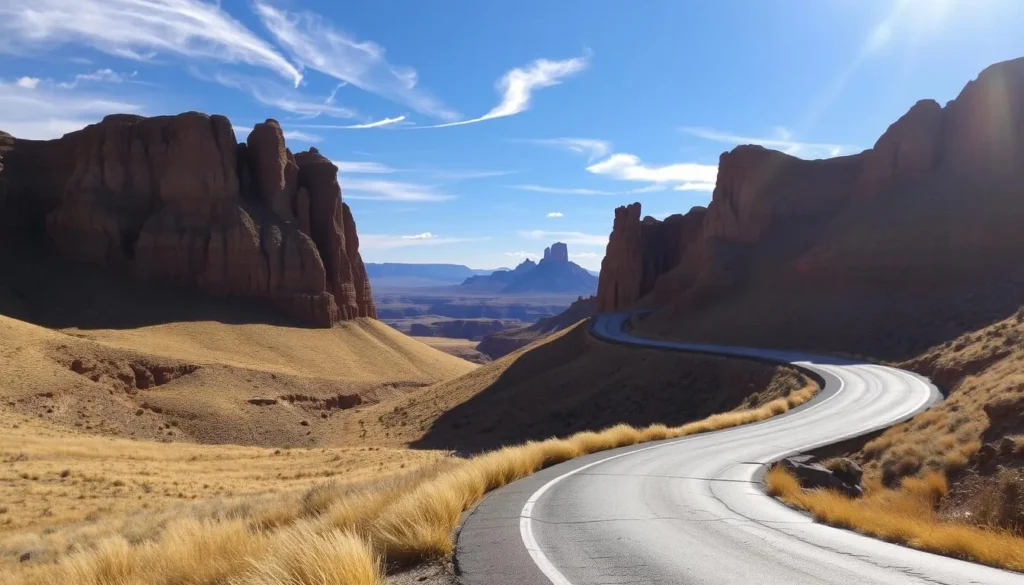
The Scenic Loop Drive serves as the main artery through the South Unit, offering access to most of the park’s major attractions, viewpoints, and trailheads. You should plan to spend at least 2-3 hours exploring the drive with stops.
Must-See Overlooks Along the Route
The drive features numerous pullouts and overlooks where you can safely stop to photograph the dramatic badlands formations and sweeping vistas of the Little Missouri River valley. Buck Hill and Boicourt Overlook stand out as must-visit stops along the route, offering some of the most spectacular panoramic views in the entire park.
These overlooks provide a glimpse into the park’s unique geological history and offer breathtaking views of the surrounding landscape.
Wildlife Viewing Opportunities
Wildlife viewing is exceptional along the Scenic Loop Drive, with frequent bison sightings and prairie dog towns that provide endless entertainment and photo opportunities. Keep a lookout for mule deer, pronghorns, coyotes, and golden eagles as you drive through the park.
Early morning and late afternoon drives offer the best lighting for photography and increased chances of wildlife sightings as animals are more active during these cooler periods.
Best Hiking Trails in Theodore Roosevelt National Park
With its unique badlands landscape, Theodore Roosevelt National Park is a hiker’s paradise. The park offers a variety of trails that cater to different fitness levels, from accessible boardwalks to strenuous backcountry routes.
Wind Canyon Trail
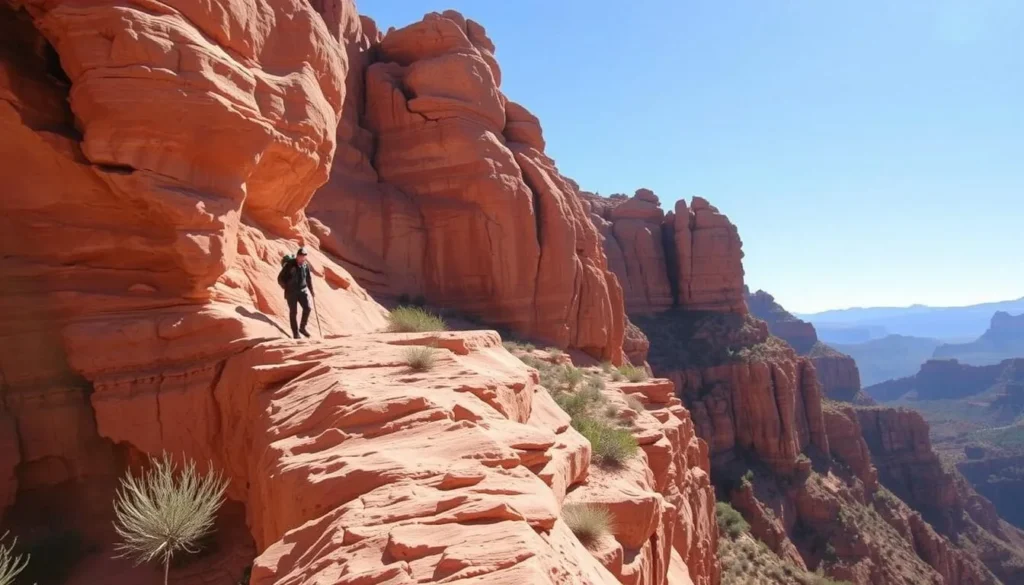
The Wind Canyon Trail is a short hike with one steep climb, but the views are worth it. This 0.4-mile round-trip hike offers spectacular views of the Little Missouri River and surrounding badlands, making it perfect for families and those with limited time.
Boicourt Overlook Trail
The Boicourt Overlook Trail provides two distinct viewpoints of the badlands in the South Unit. The second overlook requires a bit more effort but rewards you with some of the most panoramic vistas in the area.
Caprock Coulee Trail
The Caprock Coulee Trail in the North Unit delivers a more challenging 4.1-mile loop experience through diverse terrain. This trail is one of the best things to do in Theodore Roosevelt National Park, offering a unique experience.
Painted Canyon Trail
The Painted Canyon Trail extends 4.2 miles from the visitor center into the colorful badlands, offering opportunities for wildlife sightings and a deeper immersion into the park’s unique geology.
Most hiking trails in the park are best tackled in the cooler morning hours, especially during summer when afternoon temperatures can exceed 90°F. Always carry plenty of water, regardless of the season or trail length, as the arid climate and exposed terrain can lead to rapid dehydration.
Wildlife Encounters: Where and When to Spot Bison, Wild Horses, and More
As you explore Theodore Roosevelt National Park, you’ll have the opportunity to encounter a diverse range of wildlife in their natural habitats. The park is home to many animals, including bison, feral horses, elk, and bighorn sheep.
The best times to spot these animals are during the early morning and late evening hours when they are most active. You can observe them along the Scenic Loop Drive in the South Unit, where the open grasslands provide a perfect backdrop for wildlife viewing.
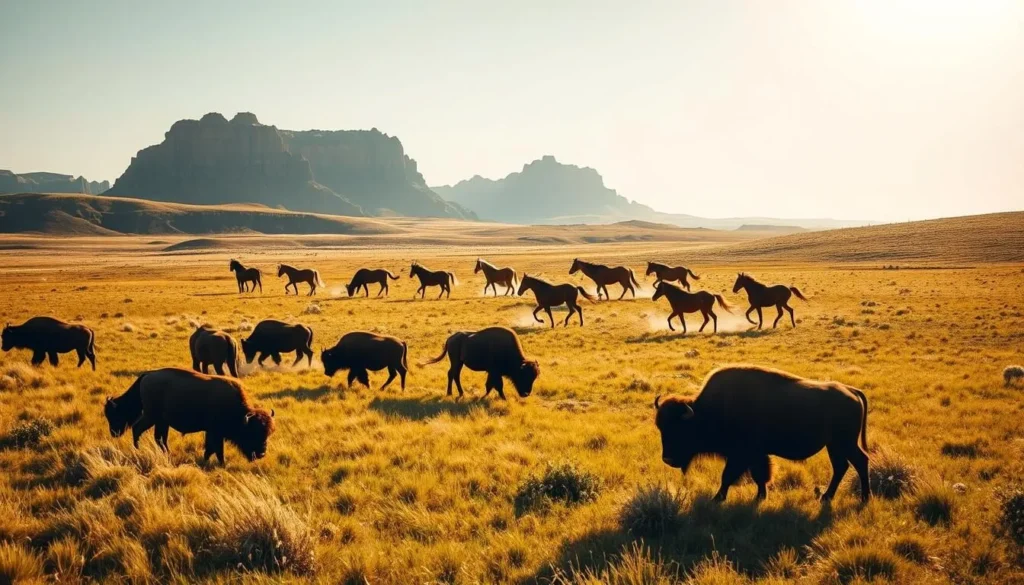
Bison Viewing Safety Tips
When encountering bison, it’s essential to maintain a safe distance. Park rangers recommend staying at least 25 yards away, roughly the length of two school buses. Never approach, feed, or touch these powerful animals, as they can be unpredictable.
- Keep a safe distance from bison to avoid any potential threats.
- Never stop your car near a bison, as this can provoke them.
- Be aware of your surroundings and keep an eye on the bison at all times.
Prairie Dog Towns
The park is known for its prairie dog towns, where these social rodents can be seen scurrying between burrows, standing sentinel, and communicating with their distinctive barking calls. Observing prairie dogs is a fun and entertaining experience, offering a glimpse into their complex social structures.
Feral Horses and Other Wildlife
In addition to bison and prairie dogs, the park is home to feral horses, descendants of ranch stock that escaped or were released decades ago. These horses can often be spotted grazing on the open grasslands, forming small bands that roam freely. Other wildlife you might encounter includes mule deer, white-tailed deer, elk, pronghorn antelope, coyotes, and numerous bird species, including golden eagles.
Theodore Roosevelt National Park, North Dakota: Best Things to Do in the North Unit
If you’re looking for a less crowded experience, head to the North Unit of Theodore Roosevelt National Park. The North Unit is located one hour north of the South Unit, accessible via US-85 north from Belfield. This unit offers a more remote and less-visited experience, with deeper canyons and more dramatic badlands formations.
North Unit Scenic Drive
The entire North Unit can be explored via the 14-mile Scenic Drive, a 28-mile round-trip journey that winds through spectacular badlands terrain. Along this road, you’ll find various attractions, including overlooks, trailheads, picnic areas, and campgrounds.
- Enjoy scenic views from numerous overlooks.
- Access hiking trails that cater to different skill levels.
- Relax at designated picnic areas.
- Stay overnight at one of the campgrounds.
River Bend Overlook
One of the highlights of the North Unit is River Bend Overlook, featuring a historic stone shelter built by the Civilian Conservation Corps in the 1930s. This shelter frames one of the most photographed views in the park, making it a must-visit spot.

Oxbow Overlook and Sperati Point
The Scenic Drive culminates at Oxbow Overlook, where you can witness a dramatic oxbow bend in the Little Missouri River. From here, you can hike the 1.2-mile trail to Sperati Point, which offers even more impressive views of the river valley.
Some key experiences to look forward to in the North Unit include:
- Exceptional wildlife viewing opportunities, with fewer visitors to disturb animals.
- A more secluded camping experience at Juniper Campground.
- Exploring the unique badlands formations and canyons.
Visiting the Historic Elkhorn Ranch Unit
The Elkhorn Ranch Unit, part of Theodore Roosevelt National Park, is a significant historical site that preserves the area where Roosevelt established his “home ranch” in 1884. This remote area within the park offers a unique opportunity to connect with the natural beauty and history of the badlands.
Theodore Roosevelt’s Legacy
Theodore Roosevelt built the Elkhorn Ranch in 1885, seeking solace after personal tragedy. It was here that he developed his conservation ethics, which later influenced his creation of national parks and monuments. The ranch played a pivotal role in shaping Roosevelt’s environmental policies, and its legacy continues to inspire conservation efforts today. You can still experience the landscape much as Roosevelt knew it, providing a powerful connection to his formative years.
Tips for Accessing This Remote Area
To visit the Elkhorn Ranch Unit, you’ll need to navigate approximately 35 miles of gravel roads, which can become impassable during wet weather. Before attempting to visit, check road conditions at a visitor center and ensure your vehicle is suitable for unpaved roads. Be prepared with water, food, and emergency supplies, as there is no cell service in the area. Once at the parking area, hike a flat 0.75-mile trail to reach the ranch site, where interpretive signs explain the historical significance.
Water Activities on the Little Missouri River
As you explore Theodore Roosevelt National Park, consider experiencing it from a different perspective by enjoying water activities on the Little Missouri River. This calm waterway runs through the park, offering a peaceful way to see wildlife. You might spot bison, wild horses, or prairie dogs.
Kayaking and Canoeing Options
The Little Missouri River winds through all three units of Theodore Roosevelt National Park, offering a unique perspective of the badlands from the water that few visitors experience. You can paddle sections of the river when water levels are sufficient, typically during late spring and early summer following snowmelt and rainfall. Canoeing and kayaking require careful planning due to fluctuating water levels.
Fishing Opportunities
Fishing is permitted in the Little Missouri River with a valid North Dakota fishing license. You might catch channel catfish, northern pike, or goldeye. Before planning your trip, check with park rangers about current river conditions, access points, and any safety concerns or closures.
Enjoying water activities on the Little Missouri River provides a serene and unique experience within Theodore Roosevelt National Park. Whether kayaking, canoeing, or fishing, you’ll have the opportunity to connect with nature and observe wildlife in a tranquil setting.
Where to Stay When Visiting Theodore Roosevelt National Park
To make the most of your visit to Theodore Roosevelt National Park, it’s essential to select accommodations that fit your plans and preferences. The park offers various options for staying, ranging from camping within the park to lodging in nearby towns.
Camping Within the Park
Theodore Roosevelt National Park offers two developed campgrounds: Cottonwood Campground in the South Unit and Juniper Campground in the North Unit. Both operate on a first-come, first-served basis. You can also experience backcountry camping throughout the park with a free permit, allowing for a more immersive overnight experience away from developed areas.
Accommodations in Medora and Nearby Towns
The historic western town of Medora, located at the entrance to the South Unit, provides the closest accommodations to the park with options ranging from hotels and motels to vacation rentals. Medora offers a unique western atmosphere with wooden boardwalks, shops, restaurants, and the famous Medora Musical outdoor show during summer months. For more lodging options, the larger town of Dickinson is located about 30 minutes east of the South Unit, offering chain hotels, restaurants, and services. Watford City serves as the gateway community to the North Unit, with limited but growing accommodation options for visitors focusing on that section of the park.
During peak summer season (June-August), accommodations in Medora fill quickly, so advance reservations are strongly recommended. The shoulder seasons of late spring and early fall offer more availability in local accommodations while still providing pleasant weather for exploring the Theodore Roosevelt National Park area.
Conclusion: Planning Your Perfect Visit to Theodore Roosevelt National Park
Theodore Roosevelt National Park, with its badlands scenery and abundant wildlife, offers an unforgettable adventure. As you plan your visit, consider the unique experiences each unit offers. The park is open all year, but spring and fall are the best times to visit, with cooler weather and fewer crowds.
To make the most of your trip, allocate at least two full days to explore both the South and North Units. If you’re interested in history, don’t miss the Elkhorn Ranch Unit. The park’s entrance fee is $30 per vehicle, valid for seven days, making it an affordable national park experience.
Accommodations range from camping within the park at Cottonwood Campground or Juniper Campground to hotels and vacation rentals in Medora and nearby towns. Enhance your visit by exploring nearby attractions like the Maah Daah Hey Trail or the North Dakota Cowboy Hall of Fame. Whether you’re a history buff, wildlife enthusiast, or photographer, Theodore Roosevelt National Park in North Dakota offers a unique blend of natural beauty and historical significance that makes it a must-visit destination.
